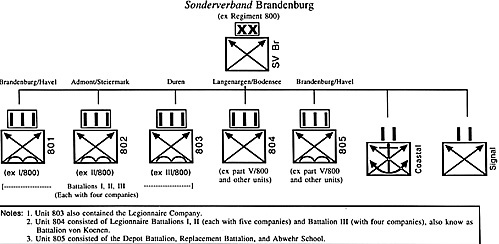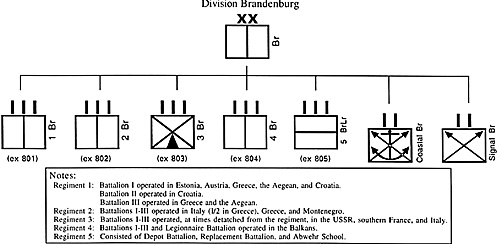1942-May 43: Operations
The Brandenburgers operated continuously in Africa, via harassment, sabotage, and insertion of spies into Egypt. The Afrika Company's major operation-the seizure of the crossings of the Nile River and Suez Canal-had to be canceled when Rommel failed to break through at El Alamein in the summer of 1942.
Summer 1942 also saw the Brandenburgers operating in support of the German offensive in the USSR. II/800, for example, helped secure the oilfields at Maikop. The Caucasus mountains--the major barrier to the German drive to the extensive oilfields of Baku--received special attention. Mixed teams of Brandenburgers and Soviet defectors attempted to raise anti-Soviet guerrillas among the many ethnic groups and "hill tribes" there. As the German offensive stalled and as the anti-German guerrilla movement gained strength behind German lines, the Brandenburgers more and more shifted from offensive actions to anti-guerrilla operations.
In Africa, the German offensive had not merely stalled but turned into a rout, as the British 8th Army smashed through at El Alamein while Allied forces stormed ashore in French North Africa. As part of the Axis response, two contingents of Brandenburgers flew into Tunisia in December 1942 to operate against the Allies. Meanwhile, the Brandenburgers under von Koenen fell back to Tunisia with Rommel.
Early in 1943, the Brandenburgers in Tunisia reorganized as Battalion "von Koenen," and operated against American forces in February. When the Axis forces in Africa surrendered in May, Battalion von Koenen refused to concede. Using small craft, the Brandenburgers crossed from Tunisia to Sicily, after which they were incorporated into the Brandenburger operations in the Balkans.
1943-4: Reorganization and Shifting Missions
In November 1942, the Brandenburgers began to reorganize. Sonderverband Brandenburg replaced Regiment 800 as the administrative headquarters, while the battalions expanded to "units:" regiments composed of several battalions. By January 1943, the Brandenburgers consisted of:

By this time, most Brandenburgers were concentrated in the Balkans. Small detachments remained in the Soviet Union, while Battalion von Koenen operated in Tunisia. The emphasis on operations had shifted. Special operations still played a role for the Brandenburgers. For example, a Brandenburger company, using a few captured T-34s, passed through the Soviet front line to reach the encircled German garrison at Velikiye Luki, during the battle there. (The Brandenburgers organized the garrison's belated breakout attempt and succeeded in getting a few hundred men back to German lines.)
However, the emphasis had shifted to defensive actions and to anti-guerrilla operations, particularly in the Balkans. While the Brandenburgers remained highly-capable troops, they began their descent from elite commandos to conventional soldiers.
In April 1943, the Brandenburgers again reorganized, taking on conventional military nomenclature. Sonderverband Brandenburg became Division Brandenburg, while the "units" became regiments. This organization appears below. Lehr Regiment 5 later split into Lehr Regiment Brandenburg, controlling replacement and instruction elements, and Lehr Regiment Kurfurst. Kurfurst controlled the depot and Abwehr School and also coordinated "intelligence missions." Lehr Regiment Brandenburg subsequently organized the "Alarm" Regiment Brandenburg for the occupation of Hungary in early 1944. The alarm regiment thereafter became Lehr Regiment Brandenburg (I-IV Battalions), which resumed replacement and instruction purposes, as well as carrying out security duties in the former Yugoslav portion of Wehrkreis XVIII.
Division Brandenburg was a division in name only and did not operate as an intact formation. Instead, its regiments, battalions, and companies operated wherever and whenever needed, from Russia to France. Brandenburgers continued to be used where highly-capable troops were needed, such as the successful recapture of Leros Island in the Aegean in November 1943 and the unsuccessful strike to capture Tito in May 1944.

Brandenburgers
- 1939: Origins and Early Operations
1940: Triumphs and Expansion
1941: To Africa and Victory in the East
1942-1943: Operations and Re-organization
1944-1945: Eclipse and Defeat
Europa Order of Battle
Back to Europa Number 32 Table of Contents
Back to Europa List of Issues
Back to MagWeb Master Magazine List
© Copyright 1993 by GR/D
This article appears in MagWeb.com (Magazine Web) on the Internet World Wide Web. Other articles from military history and related magazines are available at http://www.magweb.com